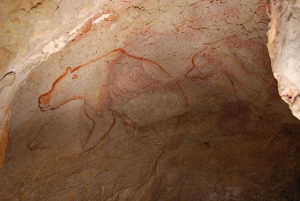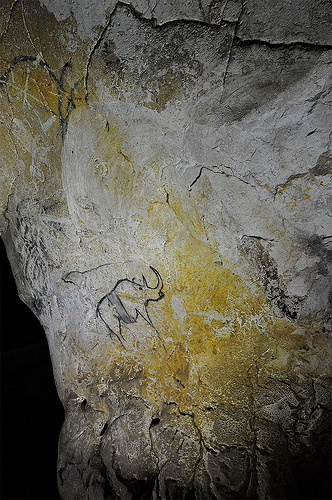
Researchers report* a chronology for Paleolithic human and animal occupation of the Chauvet-Pont d’Arc cave based on radiocarbon dates. The Chauvet-Pont d’Arc cave in southern France contains well-preserved and complex graphic panels of Paleolithic artwork. Initial radiocarbon dates revealed the artwork to be more than 30,000 years old, an age that is 10,000 years older than that predicted through stylistic considerations.
Anita Quiles and colleagues compiled more than 250 radiocarbon dates obtained over the past 15 years from charcoal pieces found on the cave floor, charcoal drawings and markings on the walls, and animal bones found within the cave. The authors incorporated the dates into statistical models to reconstruct the history of cave occupation.
The dates obtained from the charcoal samples on the cave floor and walls are consistent with two phases of human occupation, the first lasting from 37,000 to 33,500 years ago, and the second lasting from 31,000 to 28,000 years ago. The majority of animal bones found within the cave are traced to cave bears, and dates from these bones are consistent with cave bear occupation until 33,000 years ago, contemporary with the first human occupation phase. The end of the first human and cave bear occupations correlates with a rockfall that occurred approximately 34,500 years ago, as estimated by 36Cl dating. The end of the second human occupation correlates with a second rockfall 29,400 years ago that partially closed off the cave entrance, according to the authors.
_______________________________________
Black rhino at the entrance of Megaloceros Gallery, Chauvet-Pont d’Arc cave. Image courtesy of Jean-Michel Geneste, Ministère de la Culture et de la Communication
___________________________________________________
Bears in red ochre, Chauvet-Pont d’Arc cave. Image courtesy of Jean-Michel Geneste, Ministère de la Culture et de la Communication
____________________________________________________
The study report is published in the Proceedings of the National Academy of Sciences (PNAS).
Source: Edited from the subject PNAS press release
_______________________________________
*“A high-precision chronological model for the decorated Upper Paleolithic cave of Chauvet-Pont d’Arc, Ardèche, France,” by Anita Quiles et al.
____________________________________________________

______________________________________________
Travel and learn with Far Horizons.
____________________________________________
This richly illustrated issue includes the following stories: Recent findings shedding new light on the whereabouts of the remains of Philip of Macedon, father of Alexander the Great; how an archaeologist-sculptor is bringing bones of the dead back to life; archaeologists uncovering town life at the dawn of civilization; an exclusive interview with internationally acclaimed archaeologist James M. Adovasio about what makes the Meadowcroft Rockshelter prominent in the ongoing search for the first Americans; what archaeologists are finding at the site of the ancient city of Gath, the home town of the biblical Philistine giant, Goliath; and how scientists are redrawing the picture of human evolution in Europe. Find it on Amazon.com.








